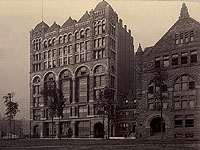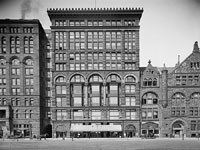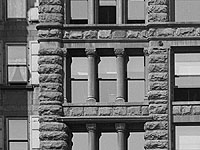|
|
WRIGHT STUDY
Browne's
Bookstore, Chicago (1907 - S.141) |
| |
|
Francis Fisher Browne Books by
and About
Browne Books
Published by Browne's Bookstore Fine Arts
Building |
|
Floor
Plan Interior of
Bookstore Art Glass &
Lighting Decorative
Designs & Furniture
Wasmuth Plate XXXVI |
|
The Dial 1900
New
Bookstore 1907 Bookstore Ads
1907 A Unique
Bookstore 1908 Books
& Articles |
|
|
Located adjacent to the
Auditorium Building on Michigan Avenue, the Fine Arts
Building was originally The Studebaker Building, a carriage
factory and showroom. By 1895, the building proved
insufficient, and the Studebakers decided to convert the
building into studios and theaters to be an artistic and
literary center. The renovated ten story building
opened in the summer of 1898. It soon became a hub for
writers, artists, musicians, publishers, galleries,
societies and Wright himself, from 1908 through 1910. It
became known as "the first art colony in Chicago". Wright's
interest in publishing and Japanese prints lead him to
become a member of
The Caxton Club
which was located on the tenth floor of the building. Both
Francis Fisher Browne and Wright were members. Wright's
interest in publishing limited edition books went back to
1896 with his involvement in "The
Eve of St. Agnes" and "The
House Beautiful" 1896-1898. Another member of the
Caxton Club was publisher Ralph Fletcher Seymour who located
his publishing company in The Fine Arts Building. In 1911,
he published "The
Morality of Women" for Wright and Mamah Bouton
Borthwick (Cheney) as well as two other volumes. In 1912
Seymour published Wright's first edition of "The
Japanese Print".
Another tenant in the Fine
Arts Building was The Arts Club of Chicago. Wright held an
Exhibition there of Japanese Prints entitled "Antique
Colour Prints From The Collection of Frank Lloyd Wright"
beginning November 12 and ending December 15, 1917.
"The Dial", a
semi-monthly journal of Literary criticism, discussion and
information, founded by Francis Fisher Browne also had
offices in the Fine Building.
Wright's first project in the
Fine Arts Building was a bookstore on the seventh floor for
Francis Fisher Brown, (1907 - S.141). Wright's second and
third projects were the Thurber Art Gallery (1909 - S.154)
which occupied the entire fifth floor, and the Mori Oriental
Art Studio (1914 - S. 181) on the eighth floor.
It might well be said that
Francis Fisher Browne was as much a "formative
influence in American literature"
(BD p240) as Frank
Lloyd Wright was in the field of architecture.
Francis Fisher Browne was
born on December 1, 1843 in South Halifax, Vermont. His
father, William Goldsmith Browne was a well-known editor,
poet and printer in Massachusetts. Francis worked in his
father's print shop in Chicopee until the summer of 1862
when he served in the Massachusetts regiment. From 1866-67
he studied law in Rochester, New York and at the University
of Michigan. But, like his father, his heart was drawn to
the written word. After a year in Michigan, he moved with
his wife Susan Seaman Brooks to Chicago where he became the
editor of
"The Western Monthly"
in 1869. Within two years he bought an interest in the
magazine, and once gaining control, changed the name to
"The Lakeside Monthly".
It became one the best monthlies in the country. He formed
the Chicago Literary Club in 1874. The nation experience the
financial panic of 1873, and Browne's health suffered
greatly, forcing him to give up the magazine in 1874. Unable
to attend his beloved Literary Club, and unable to pay the
dues, he was expelled from the club (Prophet
p13). It was not until 1899 that he once again
became an honorary member.
Gaining his strength, and
partnering with Jansen, McClurge & Co., he founded "The
Dial" in 1880. Under Browne's leadership as founder and
editor of "The Dial", it became the premier literary
magazine in the nation. In 1892 full ownership was
transferred to Browne.
Besides his editing
responsibilities he wrote and edited a
number of books.
Few photographs remain,
documenting the short life of Browne's Bookstore. In the
July 27, 1907 issue of
Publishers' Weekly, it was announced "...The Dial
Company of Chicago is to open in that city a large and
well-equipped bookstore early in October..." In the November
issue of The Dial, it was
announced that "Browne's Bookstore, in the Fine Arts
Building on Michigan Boulevard, is now open..." Shortly
after its completion, Henry Fuermann and Sons photographed
the bookstore. The Architectural Record published image
#3, view of the front cove in the March
1908 issue, in Wright's now famous
"In the Cause of
Architecture". Publishers'
Weekly published an extensive article on the
bookstore in the August 15, 1908 issue and included image
#5 View from entry to back
and |
|
image #4 View
from front to back.
Wright must have been pleased with the outcome of
Browne's Bookstore, because he included six images in
"Frank
Lloyd Wright, Ausgeführte
Bauten",
1911, pages 100, 104-107.
The space is divided into two rooms. In the larger,
there is an arrangement of alcoves along one side; each
alcove has its chairs and table and reading light. The
shelves extend only part way up the walls, giving the effect
of a home library. By a unique system of shelf-lighting, the
title of every volume from top shelf to bottom may easily be
read, while at the same time the lights are wholly hidden
from the eye. The smaller room contains no shelving, but is
arranged with cases and tables for the display of fine
bindings and special editions. A large fire-place and
comfortable easy-chairs give this the appearance of an
attractive living-room. Every fixture and every piece of
furniture in both rooms has been specially designed and
manufactured to order. The cases, tables, chairs, and wall
trimmings are of quartered oak throughout.
The book shop has lowered its ceilings, economized its
space, and set between every tier of shelves - for the
shelves are disposed as in some libraries, at right angles
to the wall - a long library table, with dependent reading
lamps, high-backed chairs, and every convenience for passing
a pleasant afternoon.
(Excepts from "A Unique Bookstore"
August 15, 1908, The Published Weekly.)
Bookstores at the time were always placed on the
ground floor and visible from the main thoroughfare. Browne
throw conventional wisdom out and placed his bookstore on
the seventh floor, which could have been a viable option in
the Fine Arts Building. The concept for the interior was
also unique. He wanted the feel of a living room, complete
with fireplace. It was praised as one of the premier
bookstores "on this side of the water". But in hindsight, he
should have stayed with conventional wisdom. Even with
Wright's design and Browne's leadership, the bookstore
struggled to run profitably. It was announced that
"Browne's Bookstore will remove September 1 (1911) to
commodious quarters on the street floor... The store has for
four years occupied space on the seventh floor... and by
this move will take its place among the many high-class
shops which line this exclusive thoroughfare. Browne's
Bookstore has been known as one of the most artistically
arranged bookstores in the country, and the fittings in the
new store will be carried out in thorough harmony with this
idea." (Publishers Weekly, Aug 26, 1911).
Any semblance of Wright's design vanished.
All that remained were a few chairs and light fixtures.
In the end, the move did not help the store become
profitable. In April 1912 the directors decided to close
Browne's Bookstore.
"He to whom Chicago owes, perhaps more than any
other one man, such growth of literary taste as the city may
boast is Mr. Francis F. Browne..."
Frank Leslie's Popular Monthly, November 1892.
Frederick Cook, in
"Bygone days in Chicago" 1910, described the
"present Dial - a critical force surpassed, perhaps, by none
in America... is receiving an even larger recognition as a
formative influence in American literature."
John Burroughs wrote, "His
memory is a precious possession to us all. Such men belong
to the 'saving remnant' of which Arnold wrote so eloquently;
they help save us from the vulgar and the unworthy... I have
lost a dear friend, and every person who cherishes a high
and worthy ideal has lost a friend also." The Dial, June 1,
1913.
Francis Fisher Browne past away on May 11, 1913.
Attending physicians say Browne's illness was brought on by
overwork. He was too weak physically to recovery. Browne had
a wide acquaintance in the world of letters, and was on
terms of intimate friendship with John Muir, John Burroughs,
Joaquin Miller, Walt Whitman, Whittler, Lowell, Holmes and
other men of note.
"Francis Fisher Browne, or
Browne the Beloved as I like to call him, was one of the
finest and rarest men I ever knew. During the last five or
six years of his life, when I came to know him intimately,
my love and admiration have been constantly growing as the
noble strength and beauty of his character came more and
more clearly to view."
John Muir.
March 2011. |
| |
|
|
| |
|
|
| |
|
|
|
|
Francis Fisher Browne |
|
|
|
|
It might well be said that
Francis Fisher Browne was as much a "formative
influence in American literature"
(BD p240) as Wright was in the field of architecture.
Francis Fisher Browne was born on
December 1, 1843 in South Halifax, Vermont. His father,
William Goldsmith Browne was a well-known editor, poet and
printer in Massachusetts. Francis worked in his father's
print shop in Chicopee until the summer of 1862 when he
served in the Massachusetts |
|
regiment. From
1866-67 he studied law in Rochester, New York and at the
University of Michigan. But, like his father, his heart was
drawn to the written word. After a year in Michigan, he
moved with his wife Susan Seaman Brooks to Chicago where he
became the editor of "The Lakeside Monthly"
in 1869. Within two years he bought an interest in the
magazine, and once gaining control, changed the name to
"The Western Monthly". It became one the best monthlies
in the country. He formed...
Continued... |
|
|
|
|
|
|
|
|
Books Written By and Related to Francis F. Browne |
|
|
|
|
|
Besides his responsibilities as
owner and editor of
The Dial, Francis F.
Browne wrote and edited a number of books.
"Golden Poems By British and
American Authors",
1881.
"Bugle-Echoes; A
Collection of Poems of the Civil War, Northern and |
|
Southern"
(March) 1886.
"The Every-Day Life of Abraham
Lincoln" 1886.
He compiled and edited the seven volume set of "Laurel
Crowned Verse", 1891-1892.
"Volunteer Grain"
1895.
Continued... |
|
|
|
|
|
| |
|
Books Published by Browne's Bookstore |
|
|
|
Browne's Bookstore opened for business near the end of 1907.
In the November issue of The Dial,
it was announced that "Browne's Bookstore, in the Fine Arts
Building on Michigan Boulevard, is now open..." The first
book to be published in 1908 was about their own bookstore,
"A Notable Bookstore". The Rev.
Jenkin Lloyd Jones,
Frank Lloyd Wright's Uncle, had published an article about
the |
|
Browne's in Unity Magazine. Elia W. Peattie had also published an article about Browne's
in the New York Post. Portions of both articles were
included. (In 1911 Peattie published an article about the
Fine Arts Building in The
International Studio,
April 1911, which was
later published in "The
Book of The Fine Arts Building".) (See
Eve of
St. Agnes, No. 24, given to Peattie...
Continued... |
|
|
|
|
|
|
|
|
Fine Arts Building Chicago |
|
|
|
|
|
Located adjacent to the
Auditorium Building on Michigan Avenue, the Fine Arts
Building was originally The
Studebaker Building, a carriage factory and showroom. It was
constructed as an eight story building in 1885 and designed
by architect Solon S. Beman. Needing additional space in the
early 1890s, they demolished the smaller adjacent three
story building, and constructed the five story attached
annex. The annex was remodeled in
1910-11 and |
|
remains consistent today.
Adjacent to the annex was the original Art Institute of
Chicago, constructed in 1886-87 by Burnhan and Root. In
1892 when the Art Institute move across the street to the
present location in Grant Park, the Chicago Club occupied
the building.
By 1895, the annex proved
insufficient, and in 1896 they moved to a larger facility.
The Studebakers...
Continued... |
|
|
|
|
|
|
|
|
|
|
|
|
|
|
Interior of the Browne Bookstore |
|
|
|
|
Few photographs remain,
documenting the short life of Browne's Bookstore. In the
July 27, 1907 issue of
Publishers' Weekly, it was announced "...The Dial
Company of Chicago is to open in that city a large and
well-equipped bookstore early in October..." In the November
issue of The Dial, it was
announced that "Browne's Bookstore, in the Fine Arts
Building on Michigan Boulevard, is now open..." Shortly
after its completion, Henry Fuermann and Sons photographed
the bookstore. The Architectural Record published image
#3, view of the front cove in the March
1908 issue, in Wright's now famous
"In the Cause of
Architecture". Publishers'
Weekly published an extensive article on the
bookstore in the August 15, 1908 issue and included image
#5 View from
entry to back and image #4 View from front to
back.
Wright must have been pleased with the outcome of
Browne's Bookstore, because he included six images in
"Frank
Lloyd Wright, Ausgeführte
Bauten", 1911,
pages 100, 104-107.
The space is divided into two
rooms. In the larger, there is an arrangement of alcoves
along one side; each alcove has its chairs and table and
reading light. The shelves extend only part way |
|
up the walls, giving the effect
of a home library. By a unique system of shelf-lighting, the
title of every volume from top shelf to bottom may easily be
read, while at the same time the lights are wholly hidden
from the eye. The smaller room contains no shelving, but is
arranged with cases and tables for the display of fine
bindings and special editions. A large fire-place and
comfortable easy-chairs give this the appearance of an
attractive living-room. Every fixture and every piece of
furniture in both rooms has been specially designed and
manufactured to order. The cases, tables, chairs, and wall
trimmings are of quartered oak throughout.
The book shop has
lowered its ceilings, economized its space, and set between
every tier of shelves - for the shelves are disposed as in
some libraries, at right angles to the wall - a long library
table, with dependent reading lamps, high-backed chairs, and
every convenience for passing a pleasant afternoon.
(Excepts from "A Unique
Bookstore" August 15, 1908, The Published Weekly.) |
|
Intfp |
|
|
|
|
Image
#1-5 and 7a courtesy of "Frank
Lloyd Wright, Ausgeführte
Bauten", 1911.
Image #6 courtesy of
"Frank Lloyd
Wright
to 1910",
Manson, 1958.
Image #7b and 8 courtesy of
"A Notable
Bookstore", Browne, 1908. |
|
Int1 |
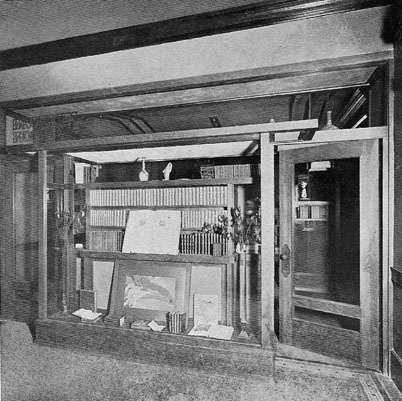 |
|
1: Exterior view of entry from hallway. Glass,
an element Wright continually experimented with,
envelops the entryway, inviting guests inside.
Two doors allow customers to enter. "Browne's
Bookstore is on the glass above the left door. |
|
Int2 |
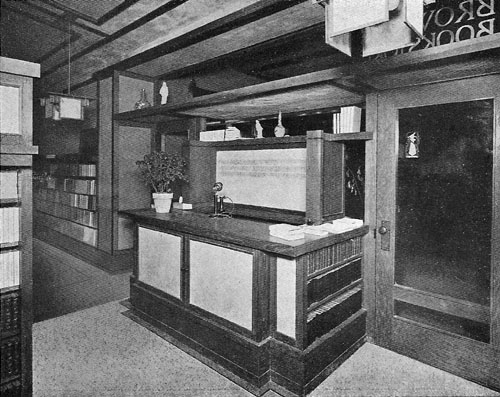 |
|
2: Interior view of
entry. The cashier's station is conveniently
situated between the two entry doors. Wright
designed every fixture and every piece of
furniture. |
|
Int3 |
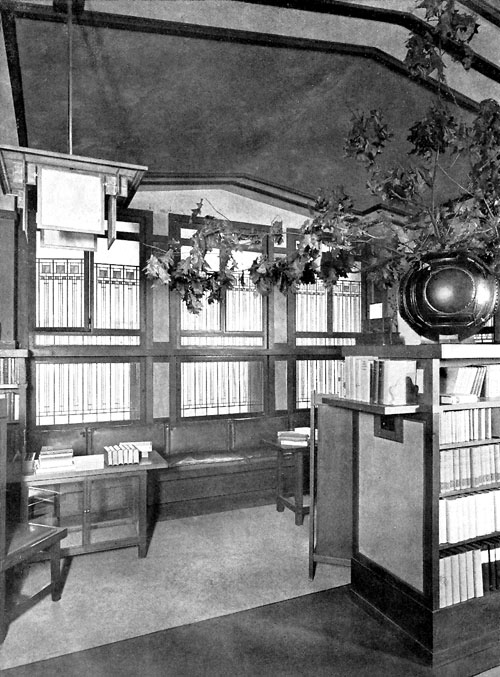 |
|
3: View of
front Cove. Browne sought to combine the best
features of a well-equipped bookstore with those
of a choice home library. Built-in seating,
high-backed chairs and tables, stained glass
windows and light fixtures, and a view of Lake
Michigan from these seventh floor windows. Wall
and ceiling trimmings were of quartered oak
throughout. Wright even designed the urn and
placed oak leaves in it. Eight urns were known
to have been produced, two of which were placed
in Browne's Bookstore. The second urn can be
seen in image no. seven. |
|
Int4 |
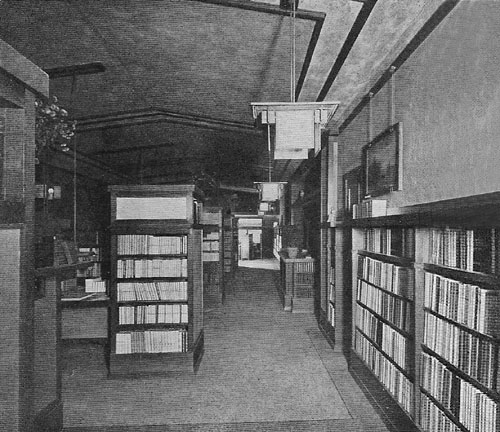 |
|
4: View from front to
back. Alcoves were arranged along the left side;
each alcove had chairs, a table and reading
light. The shelves extend only part way up the
walls, giving the effect of a home library. By a
unique system of shelf-lighting, the title of
every volume from top shelf to bottom were
easily be read, while at the same time the
lights were hidden from the eye. Every fixture and every piece of
furniture was specially designed by Wright and
manufactured to order. The cases, tables, chairs, and wall
trimmings were of quartered oak throughout. Wright also lowered
the ceiling in the main room. |
|
|
 |
|
4a: View from the entry
and cashier's desk to
back. This image was taken at a later date than
image 4. The tall pedestal book shelf directly
across from the cashier's desk has been removed
and replaced with a table. |
|
Int5 |
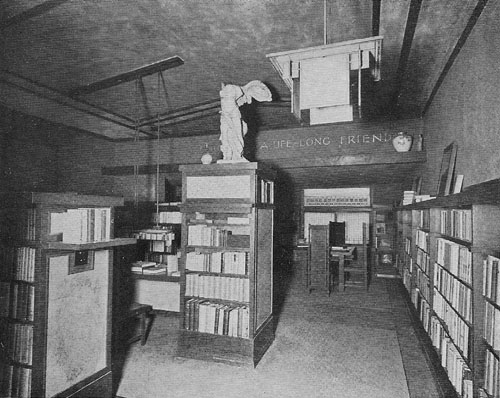 |
|
5: View from entry to back. Alcoves were
arranged along the left side; each alcove had
chairs, a table and reading light. The shelves
extend only part way up the walls, giving the
effect of a home library. By a unique system of
shelf-lighting, the title of every volume from
top shelf to bottom were easily be read, while
at the same time the lights were hidden from the
eye (PW). Set between every tier of shelves, at right
angles to the wall are long library tables, with
dependent reading lamps and high-backed chairs.
The cases, tables, chairs, and wall trimmings
were of quartered oak throughout. Wright also
lowered the ceiling in the main room. Wright
adorned the top of a book shelf with his
familiar Winged Victory Statue and quotations on
the wall. Moving from one room to the next,
Wright would often lower the ceiling, giving the
effect of immensity as you moved into the next
room. Wright dropped the ceiling in the space
between the two rooms, while continuing the
ceiling above.
See Wasmuth illustration. |
|
Int6 |
 |
|
6: View of Cove.
Each Cove included a built in table, four
high-backed chairs and
a reading light. The shelves extend only part
way up the walls, giving the effect of a home
library. By a unique system of shelf-lighting,
the title of every volume from top shelf to
bottom were easily be read, while at the same
time the lights were hidden from the eye (PW).
The book tier on the left shows the design of
the lighting system just above the top shelf. Not
only were the upper shelves recessed, but the
lower shelves were slightly slanted, angling the
books upward. |
|
Int7 |
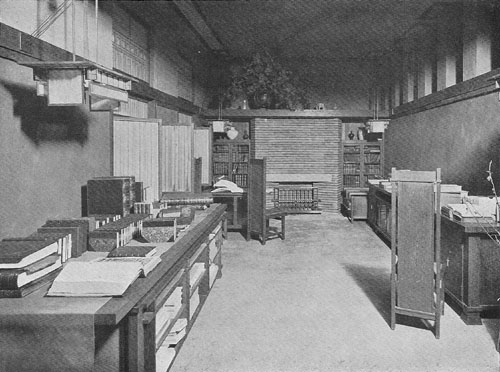 |
|
7a: View toward
fireplace. The smaller room
contains no shelving other than on either side of the
fireplace, and is arranged with cases and tables
for the display of fine bindings and special editions. A
large fire-place and comfortable easy-chairs give this the
appearance of an attractive living-room. Every fixture and every piece of
furniture in both rooms has been specially designed and
manufactured to order. |
|
|
 |
|
7b: View toward
fireplace. The smaller room contains no shelving
other than on either side of the fireplace, and is arranged with cases and tables
for the display of fine bindings and special editions. A
large fire-place and comfortable easy-chairs give this the
appearance of an attractive living-room. Published in
"A Notable
Bookstore". |
|
Int8 |
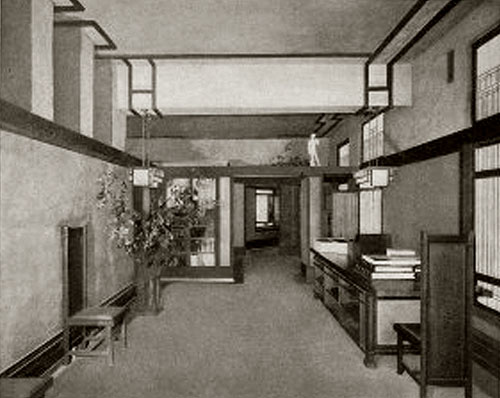 |
|
8: View from the
fireplace. It is arranged with cases and tables
for the display of fine bindings and special
editions.
Statue of David visible above doorway. Published in
"A Notable
Bookstore". |
|
|
|
|
|
|
|
|
|
|
Every fixture and piece of
furniture in both rooms were specially designed by Wright
and manufactured to order. The cases, tables, chairs, and
wall trimmings are of quartered oak throughout. This also
included the art glass and light fixtures. There are three
examples of the art glass windows in Browne's Bookstore. The
first example is in the seating cove looking out over Lake
Michigan, image #3. Wright utilized the three existing sets
of windows, each set consisting of seven repeated vertical
designs. In each set, |
|
Wright continued the design from
glass panel to glass panel, even allowing sections to open.
The second example is on the opposite end of the long room
seen in image #5. This window consisting of fourteen
repeated vertical designs. The third example is in the
smaller room. Two upper clerestory windows are visible in
image #7. This window appears to consist of eight repeated
vertical designs, and continue below the horizontal trim.
This window design was reminiscent of the windows Wright
designed...
Continued... |
|
|
|
|
|
|
|
|
|
Decorative Designs and Furniture |
|
|
|
|
|
There are four items of note in
the Browne's Bookstore. The Weed Holder, the Copper Urn, the
High-Back Chairs and the Winged Victory Statue. Wright began experimenting with
variations for designs of Weed Holders and Urns as early as 1894,
"Monograph 1887-1901" Pfeiffer, 1991, pages 60-61.
John Lloyd right wrote "Not satisfied with the
bric-a-brac of the day, Father designed his own. The copper
weed-holders pictured to the right and left of the |
|
chair are his early
creations. Father liked weeds!"
"My Father Who
is on Earth", 1946, page 24. Examples of the Weed Holder are
not as plentiful as those of the Copper Urn. It was one of Wright's
favorite objects. He included it in a number of drawings and
projects he worked on, including his own Home and Studio, the
Dana house and
Browne's Bookstore. By 1925, one
was photographed in the Taliesin III Living Room,
"Nature of Materials"...
Continued... |
|
|
|
|
|
|
|
|
|
Study of Wasmuth Plate XXXVI |
|
|
|
|
|
In 1910 Frank Lloyd Wright
produced the "Ausgeführte
Bauten und Entwürfe von Frank Lloyd Wright" (S.87),
published by Ernst Wasmuth, in Berlin. Each set consisted of
two portfolios with a combined total of one hundred separate
plates (sheets). Printed in German. The complete set
consisted of 72 plates numbered I through LXIV and included
eight with a or b. 28 were tissue overlays and were attached
to the corresponding plates. Each set also included a 31
page introduction, consisting of unbound sheets, folded
once. |
|
Plate XXXVI (36)
“Exposition building, containing an exhibition-room and lecture-room
for the Larkin Co. at the
Jamestown Exhibition;
and the interior of the Browne’s
Book-Store. A long narrow room in a down-town building converted
into a book-store. The walls and ceiling were re-formed, and
alcoves with chairs and tables provided for the convenience of
customers.” 15.75 x 25.25.
Browne's Bookstore
appeared on the bottom half of
Plate
XXXVI. Although it was published two years
after the completion of the bookstore, minor
details changed...
Continued... |
|
|
|
|
|
|
|
|
|
"The Dial, 1880-1900" May 1, 1900, The
Dial |
|
|
|
|
|
  |
|
With the
publication of the present number, The Dial celebrates its
twentieth anniversary...
The Dial was founded May
1, 1880, by Mr. Francis F. Browne, in connection with the
publishing house of Jansen, McClurg & Co., bearing the
imprint of that firm. Under these auspices, it made a
monthly appearance for a little more than twelve years. In
the summer of 1892, Mr. Browne purchased the periodical from
its previous owners, and The Dial Company was organized as a
corporation under the Illinois statute. Mr. William Morton
Payne and Mr. Edward Gilpin Johnson, both of whom had been
frequent contributors to The Dial for many years, became
formally associated with Mr. Browne in the editorship, while
Mr. F. G. Browne, who had been in charge of the business
interests of the paper since 1888, was appointed as the
business manager. It was decided to make The Dial a
semi-monthly publication, with a slight advance in the rate
of subscription. The first number of the new semi-monthly
issue was dated...
Continued... |
|
|
|
|
|
|
|
|
|
"New Bookstore and Publishing Firm in
Chicago" July 27, 1907, The
Publishers' Weekly |
|
|
|
|
|
  |
|
It has just been
announced that The Dial Company of Chicago is to open in
that city a large and well-equipped bookstore early in
October, and will later inaugurate a general book publishing
business. The company will, of course, carry on actively the
three periodicals with which it has so long been identified,
and which it has so long been identified, and which are so
well known to the trade throughout the country: The Dial,
the acknowledged leading literary journal in America; the
"Trade Book List," a monthly bulletin of new books, supplied
in imprint editions to booksellers throughout the United
States; and "What's in the Magazines," devoted to the
interests of periodicals as the first two are to books.
A special point is to be made of the decoration and
fittings of this new shop. It is said that the beauty and
distinction of the interior, as well as its comfort and
convenience, are so unusual and striking that Browne's
bookstore, as it will be called, is likely to be unique
among bookshops on this side of the water. At the same time
no essential feature...
Continued... |
|
|
|
|
|
|
|
|
|
Browne's Bookstore Ads - Nov. 16, Dec. 1 & 16,
1907, The Dial |
|
|
|
|
|
  |
|
Browne's
Bookstore, in the Fine Arts Building on Michigan Boulevard,
is now open and will be found well worth an early visit. In
the planning and fitting of this new shop, the effect sought
has been a combination of the best features of a
well-equipped bookstore with those of a choice home library.
Through the cooperation of Mr. Frank Lloyd Wright as
architect, the interior has been given a beauty and
distinction, combined with special provision for the comfort
and convenience of visitors, that make it unique among
existing bookstores...
Browne's Bookstore,
offers to Christmas buyers an opportunity to make their
selections in a notably beautiful shop, where every possible
improvement in arrangement and lighting administers to their
comfort, and where the freedom from outside distractions
will make their visit a most agreeable interval in the
fatiguing round of Holiday shopping.
All the beautiful
Holiday gift books...
Continued... |
|
|
|
|
|
|
|
|
"A
Unique Bookstore" August 15, 1908, The
Publishers' Weekly |
|
|
|
|
|
  |
|
The
choice of a location for a bookstore is always a matter of
concern and perplexity. Given a favorable vicinity, where
shall the store be located? If on the main thoroughfare...
But, wherever a bookseller will establish himself, he
insists that his store shall be on the "ground floor," in
more senses of the word than one.
...Thus far, however, only one dealer in all classes
of books has had the courage to locate his store up "in the
air," and the credit of being the pioneer in this respect
belongs to the Dial Company of Chicago, of which Francis
Fisher Browne is president, which as already noted by us,
has located Browne's Bookstore on the seventh floor of the
Fine Arts Building on the Michigan Boulevard in Chicago.
...The Fine Arts
Building in Chicago seems about the best kind of "foundation
upon which to build a bookstore, occupied, as it is, by a
clientage almost large enough, independently, to support
such an institution. In it are housed artists, musicians,
some of the leading picture dealers, the arts and crafts
people, teachers of foreign languages, book binders, the
Western offices of some of...
Continued... |
|
|
|
|
|
|
|
|
|
Text and illustrations Copyright Douglas M.
Steiner unless otherwise noted. |
|
|
|
|
|
-
Related Books and Articles
|
| |
|
"Bankruptcy Petitions
in Chicago", New York Times, May 2, 1878 |
|
The Caxton Club
of Chicago was founded in 1895. |
|
"The Dial, 1880-1900",
The Dial, May 1, 1900,
Pages 327-328. |
|
Studebaker Ad: "Pirates",
The Dial, May 1, 1901,
Page 319. |
|
Studebaker Ad: "Yankee Concul",
The Dial, December 16, 1903,
Page 487. |
|
"Twentieth Century Biographical
Dictionary of Notable Americans", Johnson;
Brown.1904,
Page 440. |
|
"New Bookstore and
Publishing Firm in Chicago"
The Publishers Weekly,
July 27, 1907,
Page 222. |
|
Ad: "Chicago's New Bookstore"
The Dial,
November 16, 1907,
Page 327. |
|
Ad: "Books for Presents at
Browne's Bookstore",
The Dial,
December 1 & 16, 1907,
Pages 394, 438 |
|
"Browne's Bookstore Art Glass Windows",
1907. |
|
"Browne's Bookstore Art Glass Fixtures",
1907. |
|
"Browne's Bookstore and the
Copper Weed Holder", 1907. |
|
"Browne's Bookstore and the
Copper Urn", 1907. |
|
"Browne's Bookstore Side
Chair", 1907. |
|
"Browne's Bookstore and the
Winged Victory", 1907. |
| "In The Cause
of Architecture", Wright, Architectural Record, March 1908. |
|
"A Unique Bookstore", Publishers
Weekly,
August 15, 1908,
Pages 352-353. |
|
"Musical Memories", Upton,
1908, Pages 345. |
| "Ausgeführte
Bauten und Entwürfe von Frank Lloyd Wright" Wasmuth,
1910, Browne's Bookstore
"Plate
XXXVI". |
|
"Browne's Bookstore and The
Wright Playroom Windows", 1910. |
|
"Bygone Days in Chicago",
Cook, 1910,
Page 400. |
|
"Frank
Lloyd Wright, Ausgeführte Bauten",
Wright, 1911,
pages 100, 104-107. |
|
"The Fine Arts Building
in Chicago", The
International Studio, April 1911, Peattie, Pages XLIV-XLVI. |
| "Browne's
Bookstore Relocates", The Publishers Weekly, Aug 26, 1911,
Page 854. |
|
"Francis Fisher
Browne. 1843-1913", The Dial, June
1, 1913,
Pages 437-443. |
|
"Browne The Beloved",
Muir, The Dial, June 16, 1913, Page 492. |
|
"Browne The Beloved", John Muir, Transcript of original
letter. |
|
"The Dial’s Puritan
Editor", Shaw, American Review of Reviews, July
1913, Pages 115-116. |
|
"The Chicago Literary Club",
Gookin, 1926, Pages 204. |
|
"Frank Lloyd
Wright to 1910",
Manson, 1958, Pages 166-167. |
|
"The Dial in Transition", Nicholas
Joost, Journal of Illinois Historical Society, August 1966, Pages
272-288. |
|
"Fine Arts
Building", Pomaranc, 1977, Pages 12. |
|
"A Prophet Without Honor in His Own
Country", Regnery, 1985, Pages 14. |
| "The Frank Lloyd Wright Companion", Storrer,
1993, Page 142. |
|
"Frank
Lloyd Wright
& The Book Arts",
Hamilton, 1993, Pages xi, 53, 66-71. |
|
"Lost
Wright"
Lind, 1996, Pages 140-141. |
"Frank
Lloyd Wright Monograph 1907 -1913", Text: Pfeiffer, Bruce
Brooks;
Edited and Photographed:
Futagawa, Yukio, 1991, Pp 90. |
|
"The Book of the
Fine Arts Building", Peattie, Swan, 2008, Pages 37. |
| |
|
|
|
| |
| |
|
BACK TO TOP |
|
|
|
|

CLICK TO ORDER













